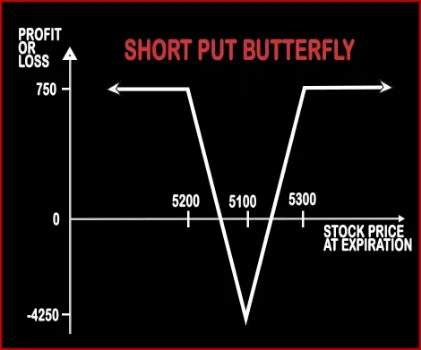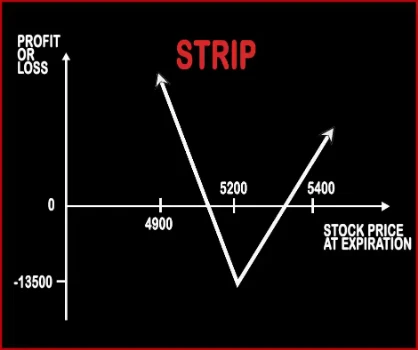Compare Strategies
| SHORT PUT BUTTERFLY | STRIP | |
|---|---|---|

|

|
|
| About Strategy |
Short Put Butterfly Option StrategyIn Short Put Butterfly strategy, a trader is neutral in nature and expects the market to remain range bound in the near future. A trader will buy 2 ATM Put Options; sell 1 ITM & 1 OTM Put Options. Here risk and returns both are limited. Risk:< |
Strip Option StrategyStrip Strategy is the opposite of Strap Strategy. When a trader is bearish on the market and bullish on volatility then he will implement this strategy by buying two ATM Put Options & one ATM Call Option, of the same strike price, expiry date & underlying asset. If the prices move downwards then this strategy will make more profits compared to short straddle because of the .. |
SHORT PUT BUTTERFLY Vs STRIP - Details
| SHORT PUT BUTTERFLY | STRIP | |
|---|---|---|
| Market View | Neutral | Neutral |
| Type (CE/PE) | PE (Put Option) | CE (Call Option) + PE (Put Option) |
| Number Of Positions | 4 | 3 |
| Strategy Level | Advance | Beginners |
| Reward Profile | Limited | Unlimited |
| Risk Profile | Limited | Limited |
| Breakeven Point | Upper Breakeven Point = Strike Price of Highest Strike Short Put - Net Premium Received, Lower Breakeven Point = Strike Price of Lowest Strike Short Put + Net Premium Received | Upper Breakeven Point = Strike Price of Calls/Puts + Net Premium Paid, Lower Breakeven Point = Strike Price of Calls/Puts - (Net Premium Paid/2) |
SHORT PUT BUTTERFLY Vs STRIP - When & How to use ?
| SHORT PUT BUTTERFLY | STRIP | |
|---|---|---|
| Market View | Neutral | Neutral |
| When to use? | In Short Put Butterfly strategy, a trader is neutral in nature and expects the market to remain range bound in the near future. | When a trader is bearish on the market and bullish on volatility then he will implement this strategy. |
| Action | Sell 1 ITM Put, Buy 2 ATM Put, Sell 1 OTM Put | Buy 1 ATM Call, Buy 2 ATM Puts |
| Breakeven Point | Upper Breakeven Point = Strike Price of Highest Strike Short Put - Net Premium Received, Lower Breakeven Point = Strike Price of Lowest Strike Short Put + Net Premium Received | Upper Breakeven Point = Strike Price of Calls/Puts + Net Premium Paid, Lower Breakeven Point = Strike Price of Calls/Puts - (Net Premium Paid/2) |
SHORT PUT BUTTERFLY Vs STRIP - Risk & Reward
| SHORT PUT BUTTERFLY | STRIP | |
|---|---|---|
| Maximum Profit Scenario | Net Premium Received - Commissions Paid | Price of Underlying - Strike Price of Calls - Net Premium Paid OR 2 x (Strike Price of Puts - Price of Underlying) - Net Premium Paid |
| Maximum Loss Scenario | Strike Price of Higher Strike Short Put - Strike Price of Long Put - Net Premium Received + Commissions Paid | Net Premium Paid + Commissions Paid |
| Risk | Limited | Limited |
| Reward | Limited | Unlimited |
SHORT PUT BUTTERFLY Vs STRIP - Strategy Pros & Cons
| SHORT PUT BUTTERFLY | STRIP | |
|---|---|---|
| Similar Strategies | Short Condor, Reverse Iron Condor | Strap, Short Put Ladder |
| Disadvantage | • High risk strategy and may cause huge losses if the price of the underlying stocks falls steeply. • Higher profit is only possible when shares get close to expiration. | Expensive., The share price must change significantly to generate profit., High Bid/Offer spread can have a negative influence on the position. |
| Advantages | • Benefits from time decay. • Traders can earn more in a rising or range bound scenario. • Benefits from a surge in volatility. | Profit is generated when the share price changes in any direction., Limited loss., The profit is potentially unlimited when share prices are moving. |